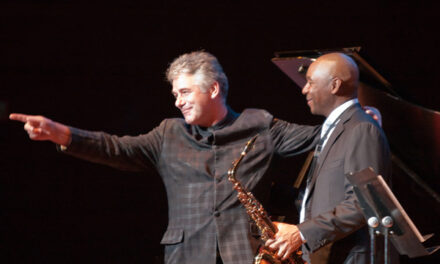The real show had an improbable starting point. Before the nearly one hundred strong Leesville Road High School Symphonic Band had taken the stage, their “grand entry” into Meymandi Concert Hall constituted a fine show in its own right. On the very grandest afternoon of the late winter, this band led by David S. Albert teamed up with the North Carolina Wind Orchestra of Michael Votta, Jr., for a joint concert.
These young people produced a maturity of sound that was nothing short of astonishing. After their slightly stylized treatment of “The Star Spangled Banner” with student conductor Caroline Amerson, they opened with Clifton Williams’ elegant “The Sinfonians.” Since the composer studied at the Eastman School of Music, he must have come under the influence of that great “bandmeister” Frederick Fennell. This concert piece evinced a magisterial quality reminiscent of William Walton’s “Crown Imperial” march, a work prominently featured by Fennell and his famous Eastman Wind Ensemble.
Among the other offerings from these youngsters was the appealingly tuneful “Song Without Words” by Gustav Holst, conducted by Sarah Bost, student teacher from Appalachian State University. And who realized that the Notebook for Anna Magdalena Bach could contain a piece so ideal for a concert band? “If Thou Be Near” from that J. S. Bach songbook is a work generally considered in choral form (usually “If Thou Art Near”). Its charm in this medium was surprising and undeniable.
After intermission the North Carolina Wind Orchestra (the sponsoring organization) took over the proceedings. This noted group opened with ten of the members constituting a “chamber” band to perform Astor Piazzolla’s unusual “Liebertango,” incorporating “formal and stylistic elements of jazz and classical music into the traditional tango.” (The quotation here is from the program notes, as complete and helpful a set as you’re likely to encounter.) A similar piece was the “Vientos y Tangos” of Michael Gandolfi, led by guest conductor Evan Feldman, and requiring from the players seemingly every action that a band can bring forth.
If you looked up the definition of “rousing,” you might well find “Shepherd’s Hey” by Percy Grainger listed as a prime example. Finally, “Dance Funambulesque” by Jules Strens provided as powerful and frenzied a conclusion as one might ever hope to experience.
Here was an imaginative and skillful pairing that combined the considerable talents of both beginners and veterans. During the intermission, one attendee declared that he was “no longer worried about the future of the North Carolina Symphony,” since here was such a fine pool of talent to draw from. He could perhaps have felt equally sanguine about the future of the North Carolina Wind Orchestra.











